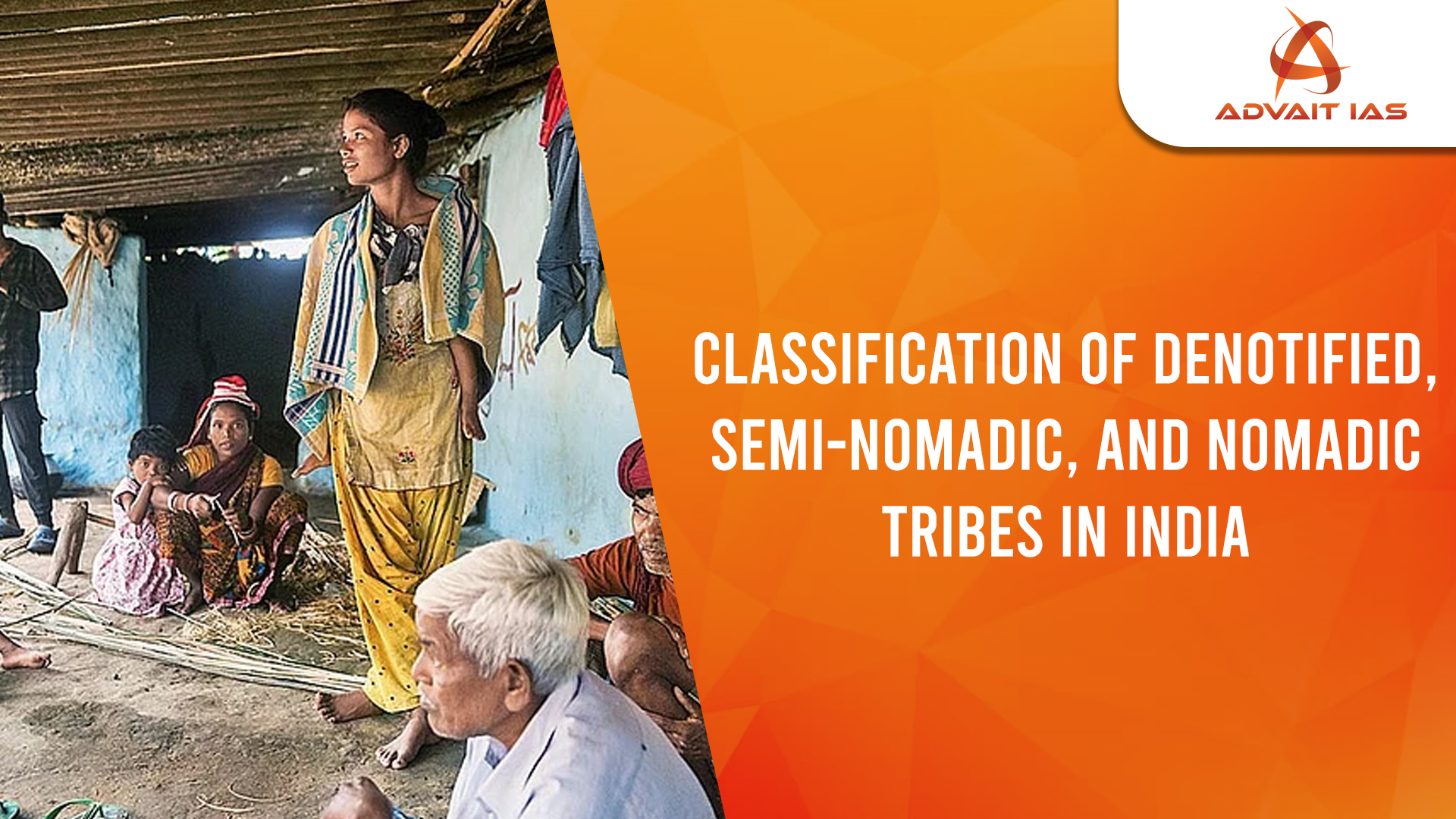The Anthropological Survey of India (AnSI) and Tribal Research Institutes (TRI) have, for the first time, comprehensively classified 268 denotified, semi-nomadic, and nomadic tribes.
Classification:
- A three-year study resulted in recommendations for 179 of these communities to be included in the Scheduled Castes (SC), Scheduled Tribes (ST), and Other Backward Classes (OBC) lists.
- 85 communities have been recommended for classification for the first time ever.
- 63 communities were found to be “not traceable,” possibly due to assimilation, name changes, or migration.
Definition and Categories
- Denotified Tribes (DNTs): Tribes that were previously notified as “criminal tribes” under the Criminal Tribes Act, 1871, later denotified after independence in 1952.
- Examples
- Mavilan (Kerala), Banjara (Rajasthan, Maharashtra), Koch (Assam)
- Historically labeled as “criminals” during British rule, now recognized as marginalized tribes.
- Nomadic Tribes: Communities that traditionally moved from place to place for livelihood, without a permanent settlement.
- Examples:
- Gaddi (Himachal Pradesh), Rebaris (Rajasthan, Gujarat) – primarily pastoral or involved in traditional crafts.
- Semi-Nomadic Tribes: Communities with a mix of settled and nomadic lifestyles, moving seasonally or for specific reasons like herding or trade.
- Examples:
- Gujar (Haryana, Rajasthan), Raikas (Rajasthan) – involved in agriculture and animal husbandry, with seasonal migration for grazing.
Historical Context and Efforts for Recognition
- Several committees and commissions have studied the issues faced by these communities:
- Criminal Tribes Inquiry Committee (1947) in the United Provinces (now Uttar Pradesh).
- Ananthasayanam Ayyangar Committee (1949), whose recommendations led to the repeal of the Criminal Tribes Act.
- Kaka Kalelkar Commission (1953), also known as the first OBC Commission.
- Lokur Committee (1965)
- B P Mandal Commission (1980), which made recommendations regarding these tribes.
- Renke Commission (2008)
- Idate Commission (2017)
- The Idate Commission (2017) reported that 267 communities remained unclassified and emphasized the urgency of completing their classification.
- A Special Committee was formed by the Prime Minister’s Office in 2019 under the Vice-Chairperson of NITI Aayog, which entrusted classification work to AnSI and TRIs.
- The classification study began in February 2020 and concluded in August 2023.
- National Commission to Review the Working of the Constitution (NCRWC, 2002)
- Held that DNTs were wrongly stigmatized as crime-prone and subjected to unjust treatment.
- Chaired by Justice M. N. Venkatachaliah.
Demographics
- South Asia has the world’s largest nomadic population.
- Census 2011: Estimates approximately 10 crore individuals belonging to nomadic and semi-nomadic tribes.
- Planning Commission (2008): A report identified that the literacy rate among these tribes is significantly lower than the national average, with limited access to formal education.
Need for Categorization
- The Parliamentary Standing Committee on Social Justice and Empowerment (December 2022) flagged the government’s inaction on classification.
- Delay in classification prevents these communities from accessing welfare benefits designated for SC, ST, and OBC groups.
- Many communities were historically misclassified due to errors in colonial censuses, which continued post-Independence.
- Incorrect classification makes organization and upliftment of these communities challenging.
Socio-Economic Challenges
- Marginalization and Discrimination: These communities were often stereotyped and discriminated against due to their mobility and non-settled lifestyles.
- Lack of Access to Education and Health: Due to their mobility, these tribes face challenges in accessing public services, education, and healthcare.
- Economic Dependence: Many rely on traditional occupations such as agriculture, animal husbandry, and handicrafts, often leading to economic vulnerability.
Government Recognition and Initiatives
- Constitutional Provisions: Articles 15(4) and 46 ensure the protection and welfare of backward communities, including DNTs.
- National Commission for Denotified, Nomadic, and Semi-Nomadic Tribes (NCDNT): Established in 2014 to address the socio-economic issues of these tribes.
Challenges Faced by DNTs
- Lack of Identity and Documentation: Many DNTs lack proper documentation such as Scheduled Tribe (ST) or Scheduled Caste (SC) certificates, affecting their access to welfare schemes.
- Stigmatization and Social Exclusion: Despite denotification, social stigma persists due to historical criminalization.
- Issues with Land Ownership: A significant portion of these tribes lack land ownership and live in informal settlements, leading to issues with land rights and security.
Government Schemes and Steps for Empowerment
- PMGDISHA (Pradhan Mantri Gramin Digital Saksharta Abhiyan): Initiatives to digitally empower DNTs, improve literacy, and access digital services.
- Welfare and Education Schemes: Several states have introduced schemes to promote education and provide vocational training specific to the needs of these communities.
The classification of denotified, semi-nomadic, and nomadic tribes is a critical step toward their social and economic upliftment. A well-defined classification will help these communities access government schemes, reservation benefits, and social inclusion.






